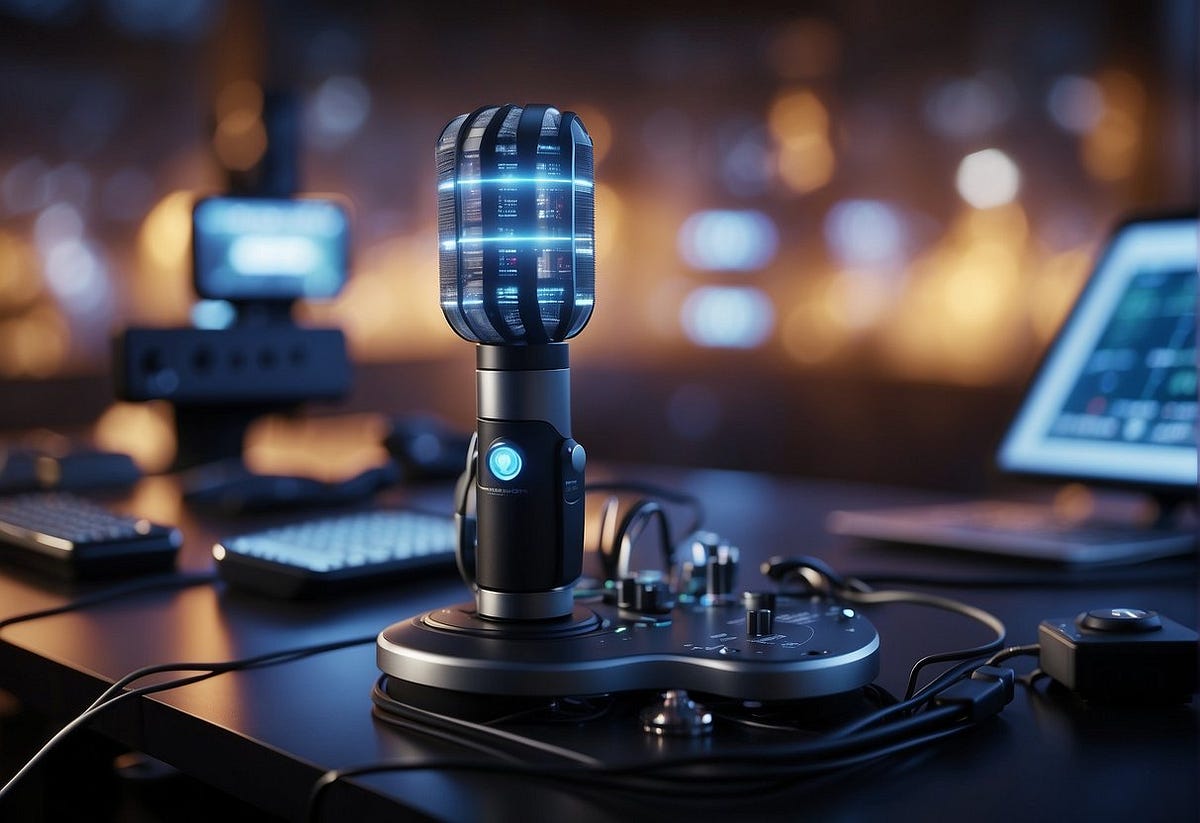AI voice generators are revolutionizing how we interact with technology. From realistic text-to-speech applications to sophisticated voice cloning, these tools leverage neural networks and deep learning to create incredibly lifelike synthetic voices. This guide explores the technology behind AI voice generation, its diverse applications across various industries, and the ethical considerations surrounding its use.
We’ll delve into the technical aspects of voice synthesis, examining different techniques and the factors influencing voice quality. We’ll also explore real-world examples, from gaming and accessibility tools to marketing and education, showcasing the versatility and potential of AI voice generators. Finally, we’ll address the ethical challenges and discuss the exciting future developments in this rapidly evolving field.
AI Voice Generators: A Deep Dive
AI voice generators are transforming how we interact with technology, offering a seamless blend of human-like speech and artificial intelligence. This technology, rapidly evolving, presents exciting possibilities across various sectors. This article provides a comprehensive overview of AI voice generators, encompassing their functionality, underlying technologies, applications, ethical considerations, and future trends.
Introduction to AI Voice Generators

AI voice generators synthesize human speech using artificial intelligence. They convert text into spoken audio or clone existing voices, creating realistic and expressive speech. This is achieved through sophisticated algorithms and vast datasets.
Types of AI Voice Generators and Underlying Technologies
Two primary types exist: text-to-speech (TTS) and voice cloning. TTS generators convert written text directly into speech, while voice cloning replicates a specific person’s voice. Both leverage neural networks and deep learning, specifically recurrent neural networks (RNNs) and convolutional neural networks (CNNs), to process and generate audio.
Real-World Applications of AI Voice Generators
AI voice generators are used extensively across numerous fields. Examples include virtual assistants (like Siri and Alexa), audiobooks, interactive voice response (IVR) systems, and accessibility tools for visually impaired individuals.
Comparison of Popular AI Voice Generators
| Feature | Murf.ai | Descript | ElevenLabs |
|---|---|---|---|
| Voice Options | Wide range of natural-sounding voices | Focus on high-quality, expressive voices | Emphasis on realistic and customizable voices |
| Pricing | Subscription-based, tiered pricing | Subscription-based, tiered pricing | Credit-based system, various pricing tiers |
| Pros | User-friendly interface, many voice options | Excellent voice quality, strong editing tools | Highly customizable voices, advanced features |
| Cons | Can be expensive for extensive use | Steeper learning curve | Can be complex for beginners |
Technical Aspects of AI Voice Generation
The creation of natural-sounding AI voices is a complex process involving several key stages. Understanding these technical aspects is crucial for appreciating the capabilities and limitations of this technology.
Training an AI Voice Generator
Training an AI voice generator involves feeding a massive dataset of audio recordings and corresponding text transcripts to a neural network. The network learns to map the text to the corresponding audio patterns, enabling it to generate new speech from unseen text.
Challenges in Generating Natural-Sounding Voices
Creating truly natural-sounding voices is challenging. Issues include capturing subtle nuances like intonation, emotion, and rhythm. Accurately replicating these aspects requires significant computational power and sophisticated algorithms.
Voice Synthesis Techniques
Various techniques exist, including concatenative synthesis (joining pre-recorded speech units) and parametric synthesis (generating speech from parameters). Parametric synthesis, often using deep learning models, offers greater flexibility and control but demands more computational resources.
Factors Influencing Voice Quality, Ai voice generator
Voice quality is influenced by factors such as sampling rate (higher rates yield better fidelity), bit depth (higher bit depths provide richer detail), and the sophistication of the underlying algorithms.
Flowchart Illustrating Synthesized Voice Creation
A flowchart would visually depict the steps: Data Collection & Preparation -> Model Training -> Text Input -> Speech Synthesis -> Post-Processing -> Output Audio. Each step would have detailed sub-processes.
Applications and Use Cases
The versatility of AI voice generators extends across diverse sectors, revolutionizing how we interact with technology and information.
AI Voice Generators in Gaming
In gaming, AI voice generators create dynamic and engaging character voices, adapting to different game situations and player interactions. This enhances immersion and realism.
AI Voice Generators in Accessibility Technologies
For visually impaired individuals, AI voice generators convert text to speech, enabling access to digital information and enhancing independence. Screen readers and text-to-speech software heavily rely on this technology.
AI Voice Generators in Personalized Learning
AI voice generators create personalized learning experiences by providing customized feedback and instructions. This adapts to individual learning styles and paces, enhancing engagement and knowledge retention.
AI Voice Generators in Marketing and Advertising
In marketing, AI voice generators create engaging voiceovers for advertisements and promotional materials. Personalized voice messages can improve customer engagement and brand recall.
Potential Future Applications of AI Voice Generators
- Real-time language translation
- Enhanced virtual reality and augmented reality experiences
- Advanced conversational AI systems
- Improved accessibility for individuals with communication disorders
Ethical Considerations and Future Trends
The rapid advancement of AI voice generation technology necessitates careful consideration of its ethical implications and potential future developments.
Potential Misuse of AI Voice Generators

Deepfakes, created using AI voice cloning, pose a significant risk of misinformation and identity theft. The ability to convincingly replicate someone’s voice can be exploited for malicious purposes.
Copyright and Intellectual Property Issues
Copyright and intellectual property rights surrounding AI-generated voices are complex and evolving. Determining ownership and usage rights remains a significant legal challenge.
Impact of AI Voice Generators on the Job Market
The automation potential of AI voice generators could displace some jobs, particularly in sectors relying heavily on voice-based tasks. However, it could also create new opportunities in AI development and related fields.
Advancements in AI Voice Generation Technology
In the next 5 years, we can anticipate more natural-sounding voices, improved emotional expression, and greater personalization options. Real-time voice synthesis with minimal latency is also expected.
Solutions to Address Ethical Concerns
- Develop robust detection methods for deepfakes
- Establish clear legal frameworks for copyright and intellectual property
- Promote responsible AI development and deployment
- Educate the public about the potential risks and benefits of AI voice generators
Illustrative Examples
To illustrate the diverse applications of AI voice generation, consider these examples highlighting the nuanced characteristics of synthesized voices.
AI voice generators are awesome for creating custom audio, right? Imagine using one to announce Real Madrid’s incredible achievement – check out the news here: Real Madrid become first team to reach 5000 LaLiga points – and then using that same AI to generate celebratory fan chants! It’s a whole new level of fan engagement, showcasing the power of AI in sports.
Synthesized Voice for a Children’s Storybook

A synthesized voice for a children’s storybook would be characterized by a high-pitched, playful tone, clear articulation, and a slightly slower pace to enhance comprehension. It would emphasize emotional inflection to convey the story’s narrative.
AI voice generators are getting pretty sophisticated these days, offering realistic and customizable speech for various applications. Want to learn how to build and integrate these tools into your projects? Check out some great resources on affordable IT courses for professionals seeking upskilling to boost your skills. Mastering AI voice tech requires a solid understanding of programming and AI principles, so upskilling is key to staying ahead in this rapidly evolving field.
Synthesized Voice for a Serious News Broadcast
A synthesized voice for a serious news broadcast would adopt a calm, authoritative tone, clear and precise articulation, and a measured pace. The voice would lack emotional inflection to maintain neutrality and objectivity.
AI voice generators are pretty cool; you can make realistic-sounding voices for all sorts of things. Imagine using one to create a dramatic news report about Jimmy Butler’s suspension – check out the details here: Heat suspend Jimmy Butler for 7 games for ‘conduct detrimental to – and then use the AI to narrate it in Butler’s own voice (or maybe even a robot Butler!).
The possibilities with AI voice tech are endless.
Synthesized Voice for a Video Game Character
A video game character’s voice might be designed with a distinct personality, reflecting the character’s age, background, and emotional state. The voice would adapt to the game’s context, reflecting action, dialogue, and environmental cues.
High-Quality vs. Low-Quality AI-Generated Voices
A high-quality AI-generated voice exhibits natural intonation, smooth transitions between words, and subtle nuances in tone and rhythm. In contrast, a low-quality voice may sound robotic, monotonous, and lack emotional expression. The difference is analogous to the difference between a professional voice actor and an amateur.
Last Point: Ai Voice Generator
AI voice generators represent a significant technological advancement with the potential to transform numerous aspects of our lives. While ethical considerations regarding misuse and copyright are crucial, the innovative applications and continuous improvements in this technology promise a future where synthetic voices seamlessly integrate into our daily experiences, enhancing accessibility, creativity, and communication. Understanding the capabilities and limitations of AI voice generation is essential for navigating this evolving landscape responsibly.
General Inquiries
How much does an AI voice generator cost?
Costs vary widely depending on features, usage limits, and the provider. Some offer free plans with limitations, while others charge subscription fees or per-minute usage.
Can I use an AI voice generator for commercial purposes?
Check the license agreement of your chosen AI voice generator. Many allow commercial use, but some may have restrictions or require additional fees.
What are the limitations of current AI voice generators?
Current generators can struggle with nuanced emotional expression, complex sentence structures, and maintaining consistency across long audio segments. Naturalness can also vary depending on the voice model and training data.
Are AI-generated voices easily detectable?
While sophisticated AI voice generators produce very realistic results, advanced detection methods are constantly being developed. The detectability depends on the quality of the generator and the sophistication of the detection tools.
